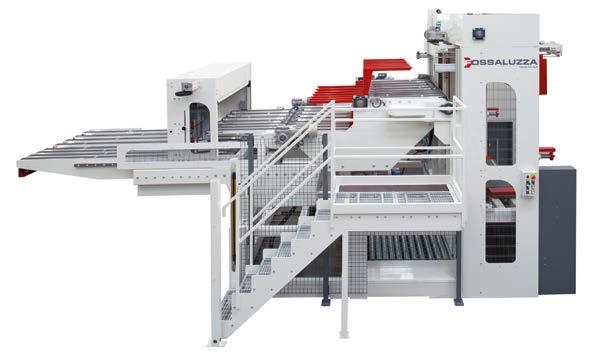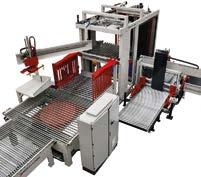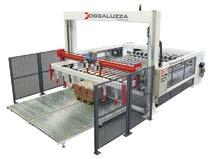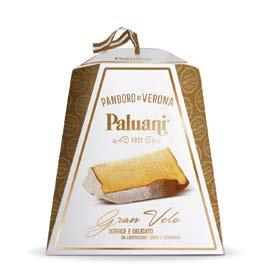
14 minute read
Christmas 2020: sober packaging and graphics
sacchetto di cellophane neutro non stampato. Diciamo che comunque il ruolo di packaging primario è quello dell’astuccio in cartoncino. Sia per il panettone che per il pandoro troviamo esempi di packaging dal profitto genetico, ovvero capaci di generare vendite e avere successo perché riescono a riunire in un’unica soluzione l’unicità del prodotto, visual, format e struttura, rendendolo riconoscibile sullo scaffale proprio per la sua unicità. In questo caso specifico stiamo parlando dell’astuccio cilindrico termosaldato utilizzato dalla Bauli per il pandoro e dell’astuccio ottagonale con quattro facciate più grandi e quattro più piccole di Melegatti, due confezioni che hanno fatto tendenza. “Parlando di packaging, la cosa divertente che mi ha visto coinvolto in prima persona con alcune di queste aziende con le quali collaboro, è il fatto che abbiamo cercato di scegliere soluzioni dal profitto genetico, ovvero differenzianti dal punto di vista strutturale e questo rappresenta il primo passo per non trovarsi coinvolti nella mera battaglia del prezzo con tutti gli altri produttori. Un’altra decisione fondamentale risultata vincente è stata quella di scegliere per ognuna di queste soluzioni dei codici colore specifici a livello aziendale. Anni fa ho collaborato con Melegatti, raggiungendo dei risultati di vendita straordinari grazie alla creazione di un’immagine del marchio ben definita per tutti i prodotti aziendali, partendo dal loro packaging dal profitto genetico del pandoro e declinandolo anche per il panettone. Da circa quattro anni gli stessi risultati eclatanti li abbiamo ottenuti riposizionando il Brand Paluani con tutta la nuova coordinazione d’immagine, capace di registrare un +40% e 2 milioni di € in più anno su anno
Fotografa il QR code qui accanto per vedere la case history sul packaging positioning che ha visto protagonista l’azienda Paluani
Advertisement
Attraverso il codice colore, dal bianco al lilla, dal rosso al blu, ogni azienda si è creata una propria identità e riconoscibilità sul mercato. Diciamocelo chiaramente, quello che una volta era percepito dai consumatori come un prodotto di “lusso”, a partire dagli anni ’90 ha notevolmente abbassato la percezione di sé, puntando a sfondare sul mercato con prezzi molto bassi, facendo perdere valore a un grande prodotto.
ENGLISH Version Christmas 2020: sober packaging and graphics for a more natural Christmas
IN A FEW WEEKS SHELVES WILL BEGIN TO FILL UP WITH PANETTONE AND PANDORO, A REAL EXPLOSION OF COLORS WILL ILLUMINATE THE STORES THAT ARE THE SCENE OF THE BATTLE OF LEAVENED PRODUCTS FOR SPECIAL OCCASIONS; MICHELE BONDANI OF PACKAGING IN ITALY IS ONE OF THE WORLD’S LEADING EXPERTS FOR THESE PRODUCTS. LET’S DISCUSS WITH HIM THE STRATEGIES THAT GUIDE CONFECTIONERY COMPANIES TO WIN THE COMPETITION EVERY YEAR AND TRANSLATE THE NEW TRENDS IN THE MARKET INTO PROJECTS...
Towards the beginning of November, put down Halloween weapons, it’s already time to think about Christmas. Panettone and pandoro are ready to challenge each other with strokes of aesthetics and captivating messages, through prints, finishings, colors and slogans to attract consumer’s attention to the dessert par excellence of Italian Christmas period. Our column “Strategies in pills” leads us to face with Michele Bondani one of the themes that made him famous among the producers of leavened products for special occasions, and which led him to collaborate with the most important Italian companies in the sector. Who better than Michele can therefore explain to us what is hidden behind the boxes we see every year and what strategies companies and marketing offices study to gain a large part of the company’s turnover in a few days. “The leavened product is the classic two-sided medal, if on one hand everything is beautiful, on the other there are pitfalls that can lead companies to the abyss. I we consider these market players, those who do not have an ongoing product in their family brand make approximately 87% of their turnover during Christmas period. In Italy, the market players capable of gaining a large part of the customer’s trust can be counted on the fingers of one hand, then we certainly find other companies that are

IL GRANDE SUCCESSO DEI PRODOTTI DI NICCHIA Negli ultimi anni si sono create pertanto nuove situazioni di mercato, che hanno visto sempre più il panettone e il pandoro di qualità inserito all’interno dei cesti natalizi, sempre e comunque in un’ottica industriale, mentre dal punto di vista artigianale c’è stato un notevole impulso nelle pasticcerie e nelle piccole produzioni capaci di ridare a questo straordinario dolce che è il panettone il ruolo di “Re delle festività natalizie” che merita, e facendo sfoggio di soluzioni di packaging molto belle, personalizzate anche nelle piccole quantità proprio grazie alle tecnologie di stampa e trasformazione digitali. “Mi viene in mente una bellissima case-history a proposito del prodotto artigianale di nicchia che riguarda un’azienda siciliana protagonista di un’azione di co-branding con Dolce&Gabbana, che ha creato un panettone tradizionale, inserendo all’interno della confezione anche una crema

spalmabile al pistacchio di Bronte e posizionando il prodotto a livelli di alta pasticceria e quindi anche a prezzi da boutique, creando un prodotto unico nel suo genere e costruendogli attorno un’aurea di unicità e di tipicità, proprio quello che cerca il consumatore oggi in un prodotto di nicchia: il panettone ha avuto successo, anche in una zona d’Italia dove il culto di questo dolce non è poi così vivo e acceso come a Milano”, aggiunge Michele.
IL PROBLEMA DELLA STAGIONALITÀ: CON VISIONE E STRATEGIA È POSSIBILE GARANTIRSI CONTINUITÀ E PRESENZA PER TUTTO L’ANNO A livello generale uno dei principali problemi che l’industria del lievitato da ricorrenza si trova ad affrontare da sempre è legato alla stagionalità di questo dolce, al contrario all’estero viene vissuto come un prodotto da consumare tutto l’anno. Se quindi queste aziende dolciarie registravano circa l’87% del fatturato nel periodo natalizio, il restante 13% viene realizzato a Pasqua con le colombe, di fatto legando le attività commerciali con tutti i rischi annessi e connessi a soli due momenti dell’anno. “Le aziende ben strutturate, gestite da manager di alto livello come ad esempio Bauli hanno capito che per garantirsi un futuro avrebbero dovuto crearsi spazi di mercato in
positioned below or above this benchmark but which do not have relevant numbers from statistical point of view”, begins Michele Bondani.
PANETTONE AND PANDORO WITH A GENETIC PROFIT PACKAGING The commonly chosen packaging solution for pandoro and panettone is the classic cardboard box inside which the product is contained in the neutral unprinted cellophane bag. Let’s say that the primary packaging role is the one of cardboard box. For both panettone and pandoro we find examples of packaging with genetic profit, these are capable of generating sales and being successful because they are able to bring together the uniqueness of the product, visual, format and structure in a single solution, making it recognizable on the shelf for its uniqueness. In this specific case we are talking about the heat-sealed cylindrical case used by Bauli for the pandoro and the octagonal case with four larger and four smaller sides by Melegatti, two packs that have set a trend. “Speaking about packaging, the funny thing that got me personally involved with some of these companies with which I collaborate, is the fact that we have tried to choose solutions with genetic profit, that is differentiating from a structural point of view and this represents the first step to avoid getting involved in the mere price battle with all the other producers. Another key decision that is resulted successful was to choose company-specific color codes for each of these solutions. Years ago I collaborated with Melegatti, achieving extraordinary sales results thanks to the creation of a well-defined brand image for all company products, starting from their packaging with the genetic profit of pandoro and also declining it for panettone. For about four years we have obtained the same striking results by repositioning the Paluani Brand with all the new image coordination, capable of recording +40% and € 2 million more year on year. Through the color code, from white to lilac, from red to blue, each company has created its own identity and recognition on the market. Let’s face it clearly, what was once perceived by consumers as a “luxury” product, since the 90s has significantly lowered its perception, aiming to break into the market with very low prices, in this way a great product lost value.
THE GREAT SUCCESS OF NICHE PRODUCTS In recent years, therefore, new market situations have arisen, which have seen more and more quality panettone and pandoro placed inside Christmas baskets, always and in any case with an industrial point of view, while from the artisan point of view there was a significant boost in pastry shops and small productions capable of giving this extraordinary panettone dessert its deserved role of “King of the Christmas holidays”, and showing off very beautiful packaging solutions, customized even in small quantities thanks to digital printing and converting technologies. “A beautiful case history about the niche artisan product concerns a Sicilian company that is the protagonist of a co-branding action with Dolce & Gabbana, which created a traditional panettone, also inserting a Bronte pistachio spread cream and positioning the product at high pastry levels and therefore also at boutique prices,
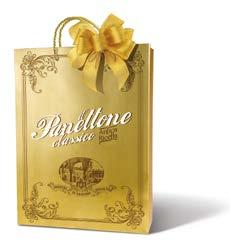

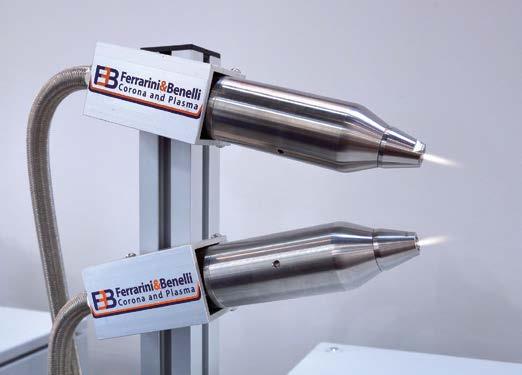

altri settori e hanno creato quindi prodotti per la colazione, per le merendine e via dicendo. Balocco, altra grande azienda molto ben gestita, qualche anno fa ha deciso di lanciarsi nell’avventura dei biscotti. Oggi Balocco, grazie a una visione strategica lungimirante è riconosciuta sugli scaffali non solo nel periodo natalizio, ma è presente a colazione con i biscotti o con le merende utilizzate dai ragazzini di milioni di famiglie italiane”. Oggi chi opera nei prodotti da ricorrenza, compreso anche per esempio il mondo del cioccolato che per circa tre / quattro mesi l’anno non è presente sugli scaffali, è necessario ingegnarsi per riuscire a vendere per dodici mesi l’anno. NATALE 2020 ALL’INSEGNA DELLA NATURALITÀ “Per quanto riguarda il packaging, lo scaffale nel periodo natalizio è sicuramente molto più ricco di referenze ma anche e soprattutto a livello di packaging, con colori sgargianti, forse anche troppo ridondanti dove tutto è portato all’eccesso. Tutto ciò il consumatore oggi non lo accetta più e la sostenibilità è sempre più l’elemento che dovrà guidare le aziende nelle proprie scelte. Al bando i materiali non riciclabili e anche tutto quell’eccesso inutile di confezioni. Credo che alla fine il consumatore premierà il prodotto meno impattante a livello ambientale e nell’immagine ma più credibile nella sostanza. Anche dal punto di vista grafico vedremo delle confezioni più sobrie, dominate dal bianco, per un Natale più naturale, di tipo svedese per intenderci. Credo che anche noi addetti ai lavori siamo chiamati a un compito non semplice ma affascinante, tenendo presente che oggi l’industria è forse più disposta ad ascoltare i nostri consigli rispetto al passato”, conclude Michele Bondani.
“Quanti giorni mancano a Natale?” Fotografa il QR code qui accanto per vedere la case history della ditta Augusta Panettoni Milano 1945
creating a unique product in its kind and building around it an aura of uniqueness and typicality, just what the consumer is looking for in a niche product: panettone has been successful, even in an area of Italy where the cult of this dessert is not lively as in Milan”, adds Michele.
THE PROBLEM OF SEASONALITY: WITH VISION AND STRATEGY IT IS POSSIBLE TO GUARANTEE CONTINUITY AND PRESENCE THROUGHOUT THE YEAR Generally speaking, one of the main problems that the recurring leavened products industry has always faced has been linked to the seasonality of this cake, on the contrary abroad it is considered a product to be consumed during the whole year. Therefore, if these confectionery companies recorded about 87% of turnover during Christmas period, the remaining 13% is achieved at Easter with doves, effectively linking the commercial activities with all the risks related and connected to only two moments of the year. “Well-structured companies, managed by high-level managers such as Bauli, understood that in order to secure a future they would have to create market spaces in other sectors and have therefore created products for breakfast, snacks and so on. Balocco, another very well managed large company, decided a few years ago to embark itself on a biscuit adventure. Today Balocco, thanks to a far-sighted strategic vision, is recognized on the shelves not only during Christmas period, but also at breakfast with biscuits or snacks used by children of millions of Italian families”. Today, those who work in anniversary products, including for example the world of chocolate which is not on the shelves for about three/four months a year, need to strive to be able to sell for twelve months a year.
CHRISTMAS 2020 IN THE NAME OF NATURALNESS “As for the packaging, the shelf in the Christmas period is certainly much richer in references but also and above all in terms of packaging, with bright colors, perhaps too redundant where everything is led to excess. Today the consumer no longer accepts all this and sustainability is increasingly the element that must guide companies in their choices. Banned not-recyclable materials and all that unnecessary excess of packaging, I believe that in the end the consumer will reward the

product with less impact on environment and in image but more credible in its substance. Also from a graphic point of view we will see more sober packaging, dominated by white, for a more natural Christmas, Swedish type to be clear. I believe that we insiders are also called to a task that is not simple but fascinating, bearing in mind that today the industry is perhaps more willing to listen to our advice than in the past”, concludes Michele Bondani.

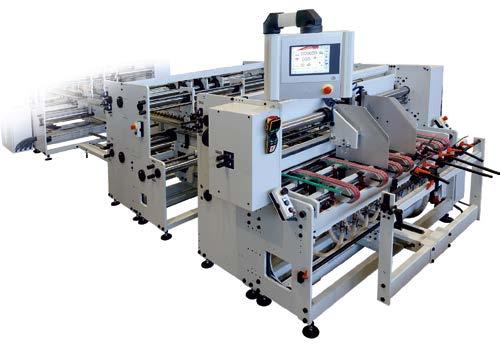
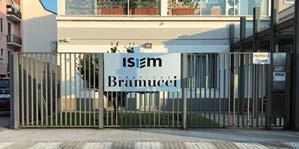
Gruppo Isem: innovazione tecnologica e sviluppo ecosostenibile per continuare a crescere e conquistare la leadership nel mercato europeo
ISEM GROUP FORMATA DALL’UNIONE DI ISEM E GRAFICHE BRAMUCCI, DUE STORICHE REALTÀ CARTOTECNICHE ITALIANE, PRODUCE OGGI 80 MILIONI DI ASTUCCI, 9 MILIONI DI SCATOLE IN 2 STABILIMENTI PRODUTTIVI (PIÙ UNA SEDE COMMERCIALE IN FRANCIA) OCCUPANDO PIÙ DI 200 DIPENDENTI. LE RECENTI NOVITÀ TECNOLOGICHE FORNITE DA BOBST AMPLIANO LE CAPACITÀ PRODUTTIVE DI ISEM CHE HA NELLA RICERCA DELL’ALTA QUALITÀ UNO DEI SUOI PRINCIPI CARDINE E PUNTA ALLA LEADERSHIP NEL MERCATO EUROPEO DI ALTA QUALITÀ
Una visione strategica molto chiara quella del Gruppo Isem, che grazie ad acquisizioni, investimenti in tecnologia, prodotti innovativi e servizi personalizzati al cliente è sempre più un punto di riferimento in Italia ed Europa, sia per le multinazionali della cosmetica, profumeria, wine&spirits che per le piccole realtà locali. Le ultime due novità tecnologiche fornite da BOBST, la MASTERFOIL 106 PR per la stampa a caldo e la NOVACUT 106 ER per la fustellatura hanno ampliato le capacità di produzione di questa azienda, che per dare qualità ai propri clienti si affida a partner tecnologici leader nei rispettivi ambiti.
LE TAPPE MILIARI NEL SETTORE CARTOTECNICO La storia di Isem, fondata a Vigevano (Pv) nel 1949 nel distretto delle calzature, è caratterizzata da passaggi strategici molto importanti, decisioni che già negli anni ’60 la ponevano ai vertici delle aziende del comparto cartotecnico, che allora vedeva Isem prevalentemente impegnata nella fornitura di scatole per le calzature e la camiceria. Ai quei tempi le lavorazioni erano per lo più manuali, ma Isem da pioniere, decise di installare, prima azienda in Europa in quegli anni, una linea automatica per la produzione di quelle scatole, fornite anche per i mercati degli accessori, lenzuola e giocattoli. La crescita a quel punto diventa inarrestabile anche grazie al fatto che le scatole assumono sempre più un ruolo di marketing per esprimere la personalità dei prodotti contenuti. Negli anni ’90 con la crisi del mercato calzaturiero e la produzione ormai spostata sui mercati asiatici, Isem coglie l’opportunità di specializzarsi nel settore del packaging cosmetico, e inizia una collaborazione con marchi di caratura internazionale, dimostrando una capacità organizzativa e produttiva in grado di soddisfare le esigenze di altissima qualità di questi marchi del lusso. La crescita anche in questo caso è repentina, e Isem diventa un punto di riferimento per la produzione dei cofanetti promozionali per profumeria, che vengono utilizzati dai marchi per le occasioni speciali e che fanno da preludio al lancio di nuovi prodotti.
SERVIZI SU MISURA PER I CLIENTI DEL LUSSO “Crescendo a ritmi vertiginosi, nel corso degli anni, grazie alle ottime referenze, abbiamo ampliato il raggio d’azione anche al mercato della cosmetica e wine&spirits, diventando un punto di riferimento per i nostri clienti”, racconta Francesco Pintucci, CEO di Isem Group dal 2016 anno in cui è divenuto promotore di un ambizioso piano industriale finalizzato a portare l’azienda ai vertici del mercato europeo. “Una volta soddisfatte le esigenze di qualità richieste dai nostri clienti è venuto direi quasi spontaneo ampliare i servizi a loro disposizione e ci siamo specializzati pertanto anche nel riempimento dei cofanetti e in tutta la gestione logistica, diventando un importante interlocutore
EVOLUTION...
